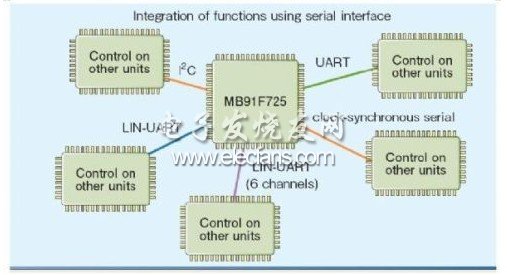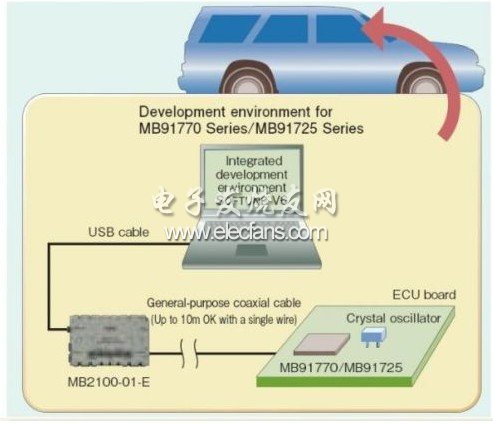introduction
In the current car design, people are paying more and more attention to the two aspects of intelligence and environmental protection. Because intelligent cars can bring people a high degree of safety and comfort, in terms of environmental protection, the use of digital technology to achieve energy saving and carbon saving purposes. Therefore, the degree of digitization is getting deeper in the automotive field, from power transmission systems to small car entertainment systems, and electronic components are everywhere, and they are widely used in sensing and control.
In various systems of automotive electronics, microcontrollers (MCUs) are often used as the core of operational control, and the reliance of automobiles on electronic systems also stimulates the rapid growth of the automotive microcontroller market. Microcontrollers for cars cover 8-, 16-, and 32-bit low-, medium-, and high-end product grades, each with its own suitable application system, roughly as follows:
8-bit MCU: mainly used in various sub-systems of the car body, including fan control, air conditioning control, wipers, sunroof, window lift, low-end instrument panel, hub box, seat control, door control module, etc. control function.
16-bit MCU: Main applications are power transmission systems such as engine control, gear and clutch control, and electronic turbine systems; also suitable for chassis mechanisms such as suspension systems, electronic power steering wheels, torque dispersion control, and Electronic pumps, electronic brakes, etc.
32-bit MCU: Main applications include dashboard control, body control, multimedia information system (TelemaTIcs), engine control, and emerging intelligent and real-time safety systems and power systems, such as pre-crash (pre-crash), adaptive Safety functions such as cruise control (ACC), driver assistance systems, electronic stability programs, and complex X-by-wire transmission functions.
1 Common interface of MCU for vehicle
CAN and LIN are relatively common interfaces.
As today's automotive requirements for application functions are getting higher and higher, the systems to be integrated are becoming more and more complex, making the demand for high-end 32-bit MCUs in automotive electronic systems increasing. Such vehicle MCUs are often placed in an operating environment with high heat, dust, shocks, and severe electronic interference, so the requirements for tolerance are much higher than general-purpose MCUs. In addition, in the automotive application environment, the automotive MCU must be connected to multiple automotive electronic control devices (ECUs), among which the most common transmission interfaces are CAN and LIN.
CAN is divided into high-speed CAN and low-speed CAN. The transmission rate of high-speed CAN can reach 1 Mbps, which is suitable for applications that emphasize real-time response such as ABS and EMS. Low-speed CAN can reach 125 Kbps, which is suitable for lower speed car body parts control. In addition, the types of CAN controllers can be divided into the old 1.x, the standard 2.0A and the extended 2.0B. The newer the specifications, the better the performance. The 2.0B can be divided into passive (passive) and Active (acTIve) type.
LIN is a lower speed and lower cost communication solution than CAN. It adopts the concept of a master node and multiple slave nodes (supports up to 16 nodes), up to 20 kbps data transmission rate, and the length of the bus cable can be expanded to 40 meters. It is very suitable as climate control, mirrors, door modules, seats, smart switches, and low-cost sensors. Distributed communication solutions for simpler systems.
The following will introduce a new generation of MCU technology applied to dashboard control and body control, and take Fujitsu's new generation of MB91770 series and MB91725 series of new microcontrollers as design references. Please refer to (Figure 1).

Figure 1 The application of instrument panel control and body control MCU in automobiles
2 Essentials of car dashboard and body control design
The dashboard of the car provides a variety of real-time visual information for the driver. This information is an important reference for assisting decision-making and must be quickly and accurately communicated to the driver. In addition, the air conditioning and body control module (BCM) system in the car is responsible for providing a comfortable ride environment for drivers and passengers. Among them, the optimal control of the air conditioning system quickly reduces the temperature inside the car to a more comfortable level, and maintains a comfortable interior temperature based on the information from various sensors. The BCM system can centrally control multiple ECUs, such as doors, seats, and combination switches.
Whether it is an instrument panel control or body control MCU, it must provide higher processing performance, the ability to handle a large number of network nodes, interface functions that support multiple peripheral connections, functions that can expand the scope of circuit board layout, and advanced memory architecture. And a more convenient development environment.
2.1 High processing performance
To improve processing performance, MCU must start from its core and software and hardware system architecture. Take the FR81S CPU core of Fujitsu's new generation MCU as an example. Its working performance reaches 1.3MIPS / MHz, which is 30% higher than the previous generation FR60 core. Efficiency; due to the built-in single-precision floating-point arithmetic unit (FPU), it can meet the requirements of image processing systems and those systems that require floating-point operation functions (such as brake control). In addition, through hardware-based FPU support, it can simplify software programs and improve computing performance.
2.2 Processing capacity of a large number of network nodes
There are a large number of built-in ECUs in the CAN network in today's cars. Their scale continues to expand with the increase in the number of nodes. Therefore, MCUs for vehicles must support more message buffers. The previous generation of 32-bit CAN microcontrollers can provide up to 32 built-in message buffers, but now it is not enough to use. For the new generation of Fujitsu MCU, it can already support up to 64 built-in message buffers, and support CAN 2.0A / B specification and provides high transmission rate of 1Mbps.
2.3 Broad interface support capability
The peripherals connected to the MCU for vehicles are quite diverse, and the connected interfaces may be UART, frequency synchronous serial, LIN-UART and I2C, so they must have flexible interface connection capabilities. In order to meet this demand, Fujitsu uses the built-in multifunctional serial interface as a serial communication interface, and switches the above-mentioned various interfaces through software to flexibly support the communication specifications of external components and increase the freedom of system design. The new series of MCUs also provide 6 channels of LIN-UART, so that they can communicate with more control units; among them, MB91725 series is easier to achieve the integration of various functions due to the multiple channels with timer function and A / D converter . Please refer to (Figure 2).

Figure 2 Use serial interface to achieve flexible communication interface function integration
2.4 The function of expanding the layout of the circuit board
Because the layout design of the circuit board system for vehicles is quite diverse, the MCU for vehicles must be able to meet the needs of these designs. Some feasible measures include configuring an independent power supply for the external bus interface terminal, so that there is no need to install a level shifter on the ECU board. The power supply range of this external bus interface terminal should be wide (such as covering 3.0V to 5.5V), and then it can be flexibly connected to the unit memory or image with ASIC.
Another method is to let the MCU have the built-in I / O redistribution function, and the allocation of I / O ports can be changed through software settings. In this way, designers can connect with specific peripherals more flexibly, thereby greatly improving the freedom of circuit board layout.
2.5 Advanced memory architecture
In order to improve the flexibility of work processing, embedded memory (Flash) is often built into today's automotive microcontroller systems. In the past, only Flash was used for program storage, and Flash for data was added to the architecture of the new generation MCU. This architecture not only improves the data writing speed, but also reduces the area of ​​the circuit board because it no longer requires E2PROM. In addition, storing data and programs in the Flash memory of the microcontroller at the same time also helps prevent information leakage.
2.6 More convenient development environment
General products must use the ICE main unit and verification evaluation chip for system verification. In order to reduce the complexity of verification, we provide on-chip error detection for the new generation of MCU products. It uses a single-wire debugging interface, which can achieve automotive evaluation or conformance testing, and can use a common coaxial cable to achieve communication between the small ICE main unit and the target circuit board within a range of up to 10 meters. This can simplify car evaluation that is conventionally difficult to achieve.

Figure 3 Using chip on-chip debugging to realize car evaluation
3 Conclusion
The application of electronic systems in automobiles is becoming more and more complex, and automotive MCUs are also playing an increasingly important role. Since the design of car dashboards and body controls must be based on the premise of providing accurate information to the driver and providing a comfortable ride experience, the MCU must meet higher performance and design requirements to help develop applications.
Parking lamp is either of the two smaller lights attached to the front of a car. Parking is one of the cars set alarm function, when the car parked curbside, on the left side of the parking lights flashing all the time, this feature is mainly used to remind the passing vehicles to avoid scratch during the night. European brand vehicles have this function. Many European laws, such as lateral stop by the road, there is no lights at night must open the outer parking lights, so that in the case of low visibility to other vehicles provide the warning role. Most models operate when the car stops and lights out, and then the turn signal comes to the side where the light is needed, and then the car locks the car. There are also some brands of roadside parking lights with special buttons, such as Mercedes-Benz. The power consumption of parking lights is very low, and it will not cause battery loss for a whole night.
Auto Parking Lamp Bulb
Auto Parking Lamp Bulb,Driving Lamp Bulb,Parking Driving Lamp Bulb,Halogen Parking Lamps
Heshan Jianhao Lighting Industrial Co., Ltd. , https://www.sunclubtw.com